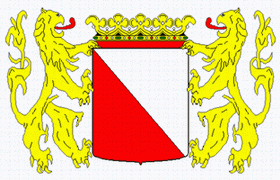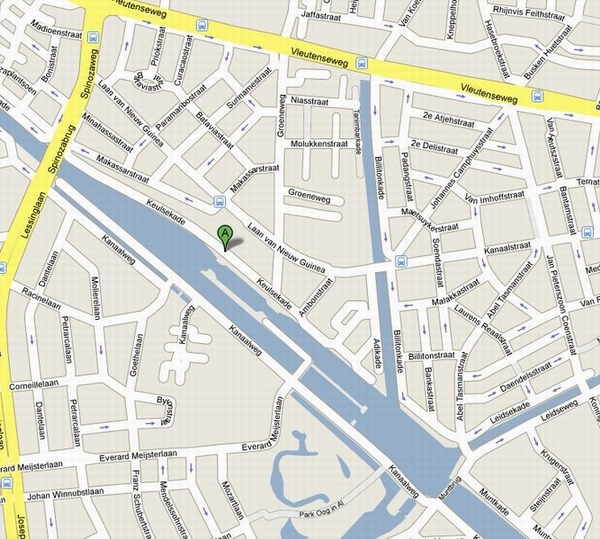| Dockings and Events |
|
| Museumship Vlotburg Castle in Utrecht starts on 03.06. till 16.06.2008 |
 |
Location: Keulse Kade - opposite the building Douwe Egberts
History
Origins (47 CE-650)
Although there is some evidence of earlier inhabitation in the region of Utrecht, dating back to the Bronze age (app. 1800-800 BCE), the founding date of the city is usually related to the construction of a Roman fortification (castellum), probably built in around 50 CE. These fortresses were designed to house a cohort of about 500 Roman soldiers. Near the fort a settlement would grow housing artisans, traders and soldiers' wives and children. A line of such fortresses was built after the Roman emperor Claudius decided the empire should not expand further North. To consolidate the border the limes Germanicus defense line was constructed.[6] This line was located at the borders of the main branch of the river Rhine, which at that time flowed through a more northern bed compared to today. The name of the Utrecht fortress originally was simply Traiectum denoting its location on the Rhine at a ford. Later the name was adorned with the prefix Ultra (on the far side) to distinguish it from other settlements (for example Mosa Trajectum Maastricht). Over time the two parts of the name would merge and evolve into the current name (Utrecht).[7] In the second century, the wooden walls were replaced by sturdier tuff stone walls,[6] remnants of which are still to be found below the buildings around Dom Square.
From the middle of the 3rd century Germanic tribes regularly invaded the Roman territories. Around 275 the Romans could no longer maintain the northern border and Utrecht was abandoned.[6] Little is known about the next period 270-650. Utrecht is first spoken of again in the 7th century when the influence of the growing realms of the Franks lead Dagobert I to build a church devoted to Saint Martin within the walls of the Roman fortress[6]. In ongoing border conflicts with the Frisians the church was however destroyed.
 
Centre of Christianity in the Netherlands (650-1579)
The Dom tower, with to the left behind it the remaining section of the Dom church. The two parts have not been connected since the collapse of the nave in 1674.By the mid of the 7th century, English and Irish missionaries set out to convert the Frisian. The pope appointed their leader, Willibrordus, archbishop of the Frisians; which is usually considered to initiation of archbishopric of Utrecht.[6] In 723, the Frankish king bestowed the fortress in Utrecht and the surrounding lands as the base of bishops. From then on Utrecht became one of the most influential seats of power for the Roman catholic church in the Netherlands. The see of the archbishops of Utrecht was located at the uneasy northern border of the Carolingian empire. Furthermore it had to compete with the nearby trading centre Dorestad, also founded on the location of a roman fortress.[6] The political turmoil in the Frankish realms after the death of Charlemagne, in combination with viking raids and domination lead to the downfall of Dorestad and established Utrecht as one of the most important cities in the Netherlands.[8] The importance of Utrecht as a centre of Christianity is illustrated by the appointment of the Utrecht born Adriaan Florenszoon Boeyens to pope in 1522 (the last non Italian pope before John Paul II).
[edit] Prince-Bishops
When the Frankish rulers established the system of feudalism, the bishops of Utrecht came to exercise worldly power as prince-bishops.[6] The realm of the bishopry included not only land the modern province of Utrecht (Nedersticht, 'lower Sticht') but extended to the northeast. However, the feudalist system resulted in conflict between the different lords. The prince bishopry had its conflicts with the count of Holland and the dukes of Guelders.[9] The Veluwe was soon taken by Guelders, but large areas in the modern province of Overijssel remained as the Oversticht.
[edit] Clerical buildings
The clergy built several churches and monasteries inside, or close to the city of Utrecht. Most dominant of these was the gothic Cathedral of Saint Martin, inside the old Roman fortress. The construction of this cathedral started in 1253 after an earlier romanesque cathedral had been badly damaged by fire. When the choir and transept were finished from 1320 the ambitious Dom tower was built.[6] The central nave was the last part to be constructed from 1420. By that time, however, the time of the great cathedrals had and ended and the declining finances prevented this ambitious cathedral from being finished, resulting in the construction of the central nave being suspended before finishing the planned flying buttresses.[6] Besides the cathedral there were four additional collegiate churches in Utrecht: Saint Saviour (demolished in the 16th century), on the Dom square, dating back to the early 8th century.[10]; Saint John (Janskerk), originating in 1040;[11] Saint Peter, building started in 1039 [12] and Saint Mary's church building started around 1090 (demolished in the early 19th century, cloister survives).[13] Besides these churches the city housed Saint Paul abbey [14]. The 15th century beguine monastery of Saint Nicholas, and a 14th century chapter house of the Teutonic Knights.[15]
Besides these buildings which were part of the hierarchy of the bishopric; an additional four parish churches were constructed in the city: the Jacobichurch (dedicated to Saint James), founded in the 11th century, with the current gothic church dating back to the 14th century [16]; the Buurkerk (Neighbourhood-church) of the 11th century parish in the centre of the city; Nicolaichurch (dedicated to Saint Nicholas), from the 12th century [17] and the 13th century Geertekerk (dedicated to Saint Gertrude of Nivelles) [18]
[edit] City of Utrecht
The location on the banks of the river Rhine allowed Utrecht to become an important trade centre in the Northern Netherlands. The growing town Utrecht received city rights in 1122. When the main flow of the Rhine moved south, the old bed, which still flowed through the heart of the town became evermore canalized; and a unique wharf system was built as an inner city harbour system.[19] On the wharfs storage facilities (werfkelders) were built, on top of which the main street, including houses was constructed. The wharfs and the cellars are accessible from a platform at water level with stairs descending from the street level to form a unique structure.[20][21]. The relations between the bishop, who controlled many lands outside of the city, and the citizens of Utrecht was not always easy.[6] The bishop, for example dammed the Lek at Wijk bij Duurstede to protect his estates from flooding. This threatened shipping for the city and lead to the city of Utrecht commissioning a canal, the Vaartse Rijn, to connect Utrecht to the Lek at Nieuwegein; to insure access to the town for shipping trade.
[edit] The end of independence
In 1528 the wordly powers of the bishop over both Neder- and Oversticht; including the city of Utrecht, were transferred to Charles V, Holy Roman Emperor, who became the Lord of the 17 Netherlands (the current Benelux and the Northern parts of France). This transition was not an easy one and Charles V wanted to exert his power of the citizens of the city; who had achieved a certain level of independence from the bishops and were not willing to give this power to their new lord. Charles decided to build a heavily fortified castle Vredenburg to house a large garrison with as most important task to maintain order in the city. The castle would last less than 50 years before it was demolished in an uprising in the early stages of the Dutch revolt.
Republic of the Netherlands (1579-1815)
Many of the features in Blaeus 1652 map of Utrecht can still be recognised in the city centerIn 1579 the northern seven provinces of these Low Countries signed the Union of Utrecht, in which they decided to join forces against Spanish rule. The Union of Utrecht is seen as the beginning of the Dutch Republic. In 1580 the new and predominantly Protestant state abolished the bishoprics, including the one in Utrecht, which had become an archiepiscopal see in 1559. The stadtholders disapproved of the independent course of the Utrecht bourgeoisie and brought the city under much more direct control of the Holland dominated leadership of the republic. This was the start of a period of stagnation of trade and development in Utrecht.
The city failed to defend itself against the French invasion in 1672, which was held against it in the states of the Republic. The lack of flying buttresses proved to be the undoing of the central section of the cathedral of St Martin church when Utrecht was struck by a tornado in 1674. The Treaty of Utrecht in 1713 settled the War of the Spanish Succession. Its most lasting result was the cession by Spain of Gibraltar to Great Britain. Since 1723 (but especially after 1870) Utrecht became the centre of the non-Roman Old Catholic Churches in the world.

Source: www.wikipedia.nl


Source: maps.google.nl |
|
 |
|
| |
|
|
|

